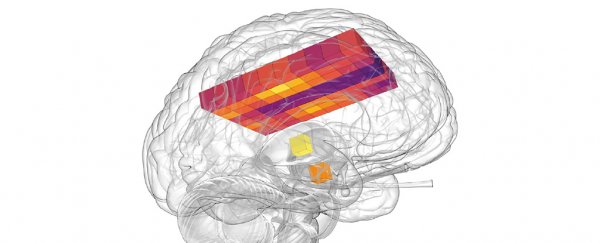From the engine in your car to the components in your laptop, mechanical systems tend to heat up when they're working harder. Now new research has revealed that the same can be said of the brain – and it runs hotter than was previously thought.
Some parts of the deep brain can get up to 40 °C (104 °F), a new study shows, though this varies by sex, time of day, and various other factors. Compare that with the average oral temperature in human bodies, which is typically under 37 °C (98.6 °F).
This isn't a sign of malfunctioning though, researchers think, and may actually be evidence that the brain is operating healthily. Unusual heat signatures could potentially be used in the future to look for signs of brain damage or disorder.
 Animation of brain temperatures over time. (N Rzechorzek/MRC LMB/Brain)
Animation of brain temperatures over time. (N Rzechorzek/MRC LMB/Brain)
"To me, the most surprising finding from our study is that the healthy human brain can reach temperatures that would be diagnosed as fever anywhere else in the body," says biologist John O'Neill from the Medical Research Council (MRC) Laboratory of Molecular Biology in the UK.
"Such high temperatures have been measured in people with brain injuries in the past, but had been assumed to result from the injury."
Previously, those measurements taken from people with brain injuries had been the primary insight scientists had into brain temperatures – which isn't the same as capturing the state of the brain during everyday life.
Here, the team used a technique called magnetic resonance spectroscopy (MRS) – measuring chemical patterns through magnetic fields – to measure brain temperature non-invasively in 40 healthy volunteers, aged from 20 to 40 years old. What's more, they combined this information with data on circadian rhythms and time of day.
The average brain temperature was 38.5 °C (101.3 °F) the researchers found, more than 2 degrees higher than under the tongue. Variations were noted based on the time of day, the brain region, and the participant's age, sex, and menstrual cycle.
Female brains were on average around 0.4°C (0.72° F) warmer than male brains, most likely due to the menstrual cycle, while the highest brain temperature recorded was 40.9 °C (105.6 °C). Daily variations averaged around 1 °C (1.8 °F), with the outer parts of the brain generally cooler.
"We found that brain temperature drops at night before you go to sleep and rises during the day," says O'Neill. "There is good reason to believe this daily variation is associated with long-term brain health – something we hope to investigate next."
The researchers have been able to use their work to put together a 4D temperature map of the brain. They're hoping that it can be used as a reference guide for what a healthy brain should look like – although much more data needs to be gathered from a much larger group of people to make it really useful.
Further tests on 114 people who had suffered a traumatic brain injury (TBI) showed that in these cases the brain temperature varied even more, from 32.6 °C to 42.3 °C (90.7 °F to 108.1 °F).
There also seems to be some link between brain temperature rhythm and the chance of surviving a TBI, although more research will be needed on this.
Add in another observation that brain temperature seems to increase with age, and it seems that regulating this temperature might be key to a healthy brain – and to surviving the effects of a significant brain injury. Temperature rhythms might also be useful as biomarkers for checking for the risk of future brain disorders.
"That a daily brain temperature rhythm correlates so strongly with survival after TBI suggests that round-the-clock brain temperature measurement holds great clinical value," says neurologist Nina Rzechorzek from the MRC Laboratory for Molecular Biology.
The research has been published in Brain.
